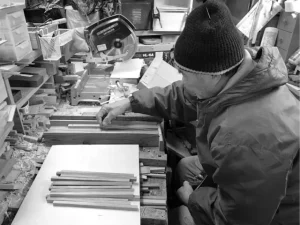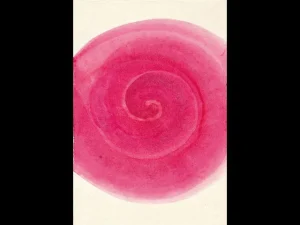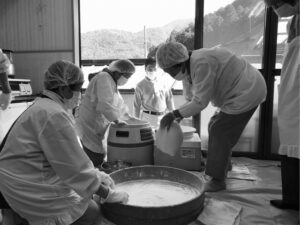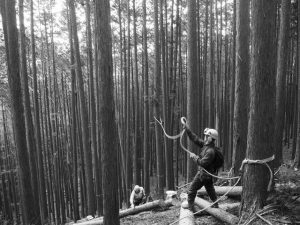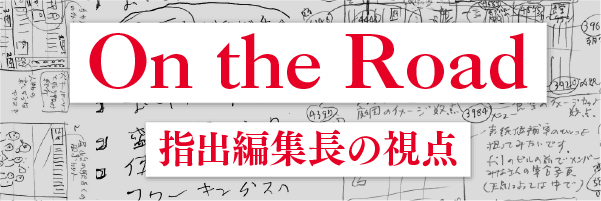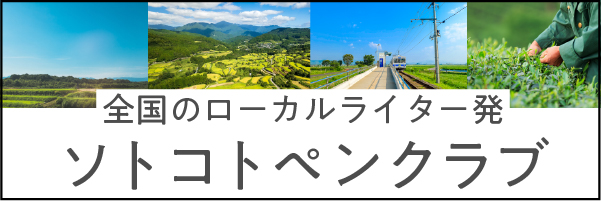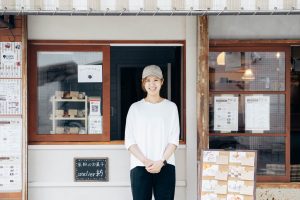2月の上旬、今年の初雪の日に僕は近所の佐久間おじさんを訪れた。おじさんの家に近づきながら、最初に気づいたのはていねいに積み重ねられた木材だった。三角に割られたその木材の隣に、カリンの木とサザンカの庭があった。僕は庭と家の間の小さな道を歩き、佐久間さんの工房へ声をかけた。雪が降るほど寒い日でも、彼は工房でバタバタしていた。おじさんは厚いコートとニットキャップの格好で出てきて、僕を工房の中へ招いてくれた。
佐久間さんは87歳だと思えない軽快さで梯子を登り、以前に作った箸や木箱を棚から取り出した。「去年、山によう行かんようになってから、こんなことばかりしとるんで!」と彼は笑った。京都府西舞鶴市出身の佐久間さんは、20代で結婚して川上村に来てから、地元の林業家に雇われ、この吉野地方でずっと山行の仕事をしてきた。彼は60年間、川上村の険しい山を登り、木を植える、草を刈る、そして木を間伐したり伐採したりする仕事をしてきた。「この奥には行ったことない山がないねん」とおじさんは誇らしく笑顔で言った。密植された吉野杉が毎年、少しずつ太くなるから、年輪も少しずつ成長する。とても繊細で素敵な年輪が生まれるが、一本の木を育てるために、100年から200年ほどかかると言われている。僕はそう考えたら、この山々の木と、それらの木を育てる人たちが計り知れない辛抱と力で生きていると感じる。
佐久間さんは自分の木工のために、昔から雇ってくれていた林業家の木材を使っている。だから使っている木材も、自分の育てた木である可能性は高い。
彼は吉野杉を木材にしたときに現れる平行の木目・柾目にこだわっている。「よその木は、やっぱり吉野杉とは比べものになりませんわ」と言い、赤みのある色合いと細かい縦縞の木目を見せてくれた。僕はこの柾目を見て、表面の美しさは見てとれたけど、佐久間さんには違うことが見えていたのだろう。木目は春から夏にかけて早く成長する「春目」と、晩夏から秋にかけてゆっくり成長する「冬目」で成り立っている。この春目と冬目で1年間が見えて、どんな作業と疲労が必要だったか、どんな生活をしないといけなかったかが、佐久間さんが分かっている。彼が表面の美しさだけではなく、その木と過ごした時間も見えているのではないか、と僕は思う。
僕が帰る前に、佐久間さんは細長くて、四角い木材を何本か出して、箸の作り方を見せてくれた。彼はかんなで木材を何回もわずかな角度で削ってから、サンドペーパーで粗を取り、4つの角に優しい丸みを加えた。箸を綺麗に仕上げたおじさんは、昔から今日までこの木を大切にしている、そういう感じがした。
Vol.21 In the Mountains and the Workshop, Time Spent with Trees
In early February, on the first snow day of the year, I visited my neighbor, Mr. Sakuma. As I approached his house, the first thing I noticed were all of the neatly stacked piles of wood. The wood was cut into triangles, and next to a garden with a quince tree and sasanqua camellias. I walked down the small path between the garden and the house, and called into Mr. Sakuma’s workshop. Even though it was so cold that it was snowing, he was still busy in his workshop. The old man came out in a thick coat and a beanie, and invited me inside.
Mr. Sakuma climbed a ladder with a lightness rare for an 87-year-old, and pulled out some chopsticks and boxes that he had made. “Since I stopped working in the mountains last year, all I’ve been doing is making things like these,” he laughed. Originally from Nishi-maizuru, Kyoto, Mr. Sakuma got married in his 20s and moved to Kawakami Village, where he was hired by a local forester to work as a yamaiki in this Yoshino region. For 60 years, Mr. Sakuma worked climbing the steep mountains of Kawakami Village, planting trees, cutting grass, thinning groves, and chopping trees. “There’s not a mountain back here that I haven’t been to,” he said with a prideful smile. Since the densely planted Yoshino cedar grows just a little fatter every year, the year rings also grow little by little. This produces very fine, beautiful year rings, but it is said that it takes about 100 to 200 years just to grow a single tree. When I think about that, it feels like the trees in these mountains, and the people who grow them, are living with an incalculable amount of patience and strength.
For his own woodworking, Mr. Sakuma uses lumber from the forestry family that had always employed him, so there is a high possibility that he himself looked after these trees.
He prefers to use the straight grain of Yoshino cedar, lumber cut so the year rings are parallel. “With other wood, it’s just no comparison to Yoshino cedar,” the old man said and showed me some lumber with a reddish tint and a fine, vertical lines. When I look at the straight grain, I can see and understand the beauty of its surface, but when Mr. Sakuma looks at it, he’s probably seeing something different. The grain is composed of a “spring ring” that grows quickly from spring through summer, and a “winter ring” that grows slowly from the end of summer through autumn. He can see the year of the spring ring and the winter ring in the grain, and knows what kind of work and effort was necessary, and what kind of life he had to live. I think perhaps he doesn’t just see a surface level beauty, but also the time that he spent with the tree as well.
Before I went home, Mr. Sakuma pulled out some long, skinny, cornered sticks of wood, and showed me how he makes chopsticks. After shaving the material over and over again with a kanna blade, he used sandpaper to smooth over any rough spots and round off the corners. Having finished off these chopsticks nice and clean, it felt like this old man has been taking precious care of this tree from a long time ago all the way to today.





